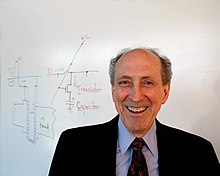Robert H. Dennard
| Robert H. Dennard | |
|---|---|

Dr. Robert H. Dennard, IBM Fellow, beside his drawing of a DRAM cell (circuit schematic)
|
|
| Born | September 5, 1932 (age 84) |
| Notable awards |
Harvey Prize (1990) IEEE Edison Medal (2001) IEEE Medal of Honor (2009) Kyoto Prize (2013) |
Robert Dennard (born September 5, 1932) is an American electrical engineer and inventor.
Dennard was born in Terrell, Texas, U.S.. He received his B.S. and M.S. degrees in Electrical Engineering from Southern Methodist University, Dallas, in 1954 and 1956, respectively. He earned a Ph.D. from Carnegie Institute of Technology in Pittsburgh, Pennsylvania, in 1958. His professional career was spent as a researcher for International Business Machines.
In 1968, he invented dynamic random-access memory (DRAM). Dennard was also among the first to recognize the tremendous potential of downsizing MOSFETs. The scaling theory he and his colleagues formulated in 1974 postulated that MOSFETs continue to function as voltage-controlled switches while all key figures of merit such as layout density, operating speed, and energy efficiency improve – provided geometric dimensions, voltages, and doping concentrations are consistently scaled to maintain the same electric field. This property underlies the achievement of Moore's Law and the evolution of microelectronics over the last few decades.
...
Wikipedia
